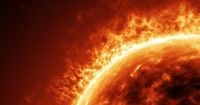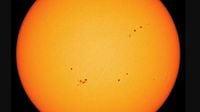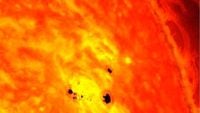A massive solar region, identified as AR 4079, is capturing the attention of scientists worldwide due to its size and potential impact on Earth. Spanning approximately 140,000 kilometers in diameter—over ten times the size of Earth—this sunspot is situated near the solar equator and is currently facing our planet directly.
Sunspots, which are temporary regions on the Sun's surface that appear darker due to their cooler temperatures, arise from intense magnetic activity. While the standard temperature of the Sun's surface hovers around 5,000°C, sunspots can drop to about 3,300°C. The peculiar characteristics of AR 4079, classified as a beta-gamma-delta type sunspot, indicate a complex magnetic structure that could lead to significant solar events.
According to NASA's Brenda Culbertson, "the AR 4079 region concentrates considerable energy and is in a location that maximizes its influence on the Earth." This positioning raises concerns about the potential for solar flares and coronal mass ejections (CMEs), both of which can disrupt technological systems on Earth if directed towards us.
In recent weeks, AR 4079 has emitted several medium-intensity class M solar flares, but no large-scale CMEs have been detected yet. However, experts warn that significant activity could occur at any moment. The Earth's magnetic field acts as a natural shield against such events, but when solar energy is particularly intense, it can penetrate this barrier, resulting in geomagnetic storms.
The European Space Agency (ESA) and other space agencies are closely monitoring AR 4079's evolution using tools like the Solar Orbiter, which provides crucial insights into solar behavior and the origins of solar wind. As of May 9, 2025, some astronomers suggest that the sunspot might be weakening, which could lower the chances of a significant solar eruption. Yet, in the unpredictable realm of solar phenomena, caution is advised.
Solar cycles, which last about 11 years, dictate the frequency and intensity of sunspot appearances. Currently, we are in the ascending phase of Solar Cycle 25, with expectations that solar activity will peak around 2025. This context makes the emergence of large sunspots like AR 4079 less surprising, although its sheer size and orientation warrant close observation.
While sunspots can influence solar radiation levels, the immediate effects on Earth’s climate are relatively minor. Factors such as geographical location, atmospheric circulation patterns, and climate change play far more significant roles in short-term temperature variations. In Mexico, for example, the high temperatures experienced recently are primarily driven by terrestrial and atmospheric factors rather than the solar activity.
Historically, the most significant solar event recorded was the Carrington Event of 1859, which was triggered by a massive sunspot and resulted in widespread disruptions, including visible auroras at lower latitudes and telegraph system failures. Culbertson noted that sunspot 4079 covers about half the area of the sunspot responsible for the Carrington Event, which suggests that while it has the potential to cause disturbances, it may not lead to anything as catastrophic.
As scientists continue to monitor AR 4079, they remain vigilant for any signs of increased activity that could result in geomagnetic storms. These storms can have various effects on Earth, from beautiful auroras to potential disruptions in communication systems, navigation, and even power grids.
In conclusion, while AR 4079 poses some risks, experts do not currently anticipate immediate severe consequences for Earth. The situation remains fluid, and any significant developments will be closely tracked by space agencies. As Brenda Culbertson emphasized, "If a major solar flare occurs while AR 4079 is facing Earth, we could receive a direct impact of solar energy and particles, triggering a geomagnetic storm." For now, the scientific community continues to watch this giant solar phenomenon with a mix of caution and curiosity.






